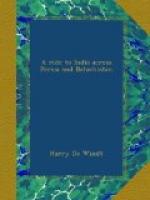I could scarcely restrain from giving vent to my admiration in speech, when the old Turk returned. In an instant the yashmak was in its place, and, with a hasty glance around, my vision of beauty was scuttling away as fast as her legs could carry her. A low musical laugh like a chime of silver bells came back to me from the dark deserted alleys of the bazaar, and I saw her no more.
The manna-seller was evidently irritated, and intimated, in dumb show, that I must leave the caravanserai at once, as he was shutting up for the night. I bought a pound or so of the sweetmeat to pacify him, and, if possible, glean some information about the fair one, but my advances were of no avail.
The history of Kashan is closely allied to that of Ispahan. The former city was founded by Sultana Zobeide, wife of the celebrated Haroun-al-Raschid. Ransacked and destroyed by the Afghans in the eighteenth century, it was again restored, or rather rebuilt, by Haji Husein Khan. Perhaps the most interesting thing the city contains is a leaning minaret which dates from the thirteenth century. It is ascended by a rickety spiral staircase. From here, not so many years ago, it was the custom to execute adulterous wives. The husband, accompanied by his relations, forced his unfaithful spouse to the top of the tower and pushed her over the side (there is no balustrade), to be dashed to pieces on stone flags about a hundred and thirty feet below.
“Pas de chance, monsieur,” was Gerome’s greeting as I entered the caravanserai. “The Koudoum Pass is blocked with snow, and almost impassable. What is to be done?” Mature deliberation brought but one solution to the question: Start in the morning, and risk it. “It cannot be worse than the Kharzan, anyhow,” said Gerome, cheerfully, as we rode out of Kashan next day, past the moated mud walls, forty feet high, that at one time made this city almost impregnable. I more than once during the morning, however, doubted whether we had done right in leaving our comfortable quarters at the caravanserai to embark on this uncertain, not to say dangerous, journey.
Twenty-nine farsakhs still lay between us and Ispahan; but, once past the Khurood Pass (which lies about seven farsakhs from Kashan), all would be plain sailing. The summit of the pass is about seven thousand feet above sea-level. Its valleys are, in summer, green and fertile, but during the winter are frequently rendered impassable by the deep snow, as was now the case. Khurood itself is a village of some size and importance, built on the slope of the mountain, and here, by advice of the villagers, we rested for the night. “It will take you at least a day to get to Bideshk,” said the postmaster—“that is, if you are going to attempt it.”




